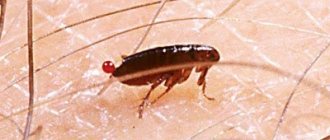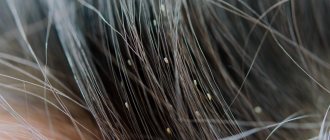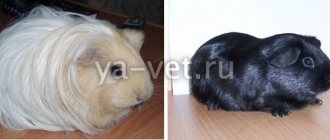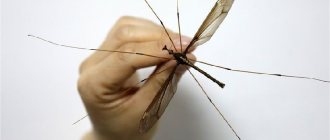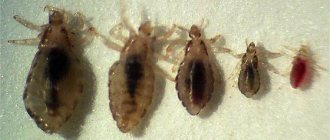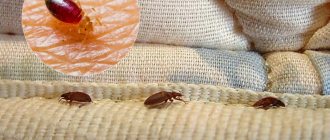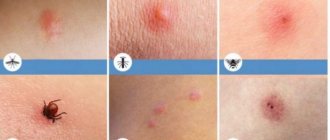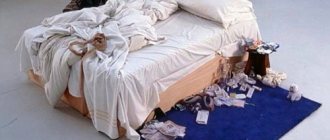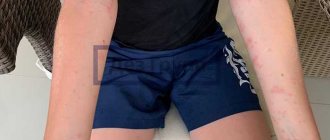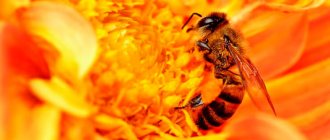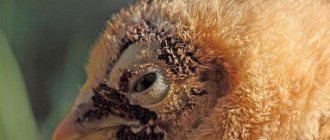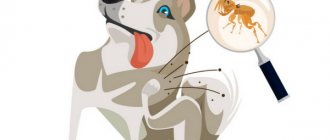What do linen lice look like: YouTube/Disinfection Center Linen lice are dangerous parasites whose bites pose a potential threat to human health. Small creatures feed on human blood and live in bedding, mattresses, pillows and blankets. What lice look like, where they come from and what to do if you have a bed louse - information that will help the housewife fight parasites.
What do linen (body) lice look like?
The appearance is not much different from other types of lice. These are insects 3 – 3.5 mm long, some individuals reach 5 mm. They have a flattened, elongated body of a light brown color. When saturated with blood, they darken and increase in size. The parasite has three pairs of legs, their shape and structure are slightly different from the legs of head or pubic lice. During its development, the body louse has adapted to move mostly not along hairs, but along clothes, linen and skin. Because of this, the legs of body lice are less tenacious than those of other species.
The mouthparts are equipped with sharp stilettos, which they use to pierce the skin. The blood is sucked out using the proboscis. They are also injected with a substance that prevents the blood from clotting. Because of this location, linen lice bites most often result in bruising.
The eggs of linen lice are the same as those of head lice. They are round, white, 1 - 1.5 mm in size. Usually females lay them in a heap, in one place. The clutch can be noticed precisely because of the large number, since the nits themselves are very small.
Folk methods of struggle
Some plants contain components that have an insecticidal and repellent effect. For prevention, dried or fresh herbs are taken and laid out in bunches in cabinets. For destruction, strong decoctions, extracts, and extracts added during washing are used.
Linen lice can be killed using various herbs.
Active substances that are harmful to linen lice are:
- wormwood;
- field milkweed;
- tansy;
- larkspur;
- hellebores.
Linen louse cannot tolerate the aroma of lavender and tea tree, so the essential oils of these plants are added to the water for washing contaminated items.
In the past, kerosene and soda ash solution were used to soak laundry. These products have a detrimental effect on lice, but today they are not used due to their health hazards.
Life cycle
This parasite goes through several stages in its development:
- nit – an egg in which a larva develops; development occurs within 5–8 days;
- nymph of the first, second and third order - the larva emerges from the egg and goes through three molts, increasing in size; this stage usually takes from 16 to 21 days;
- imago - an adult individual.
Body lice begin to bite and drink blood already at the nymph stage, but only adult insects can mate and reproduce. The female lays an average of 4 eggs per day. Over the course of its life, it lays more than a hundred nits, so lice must be dealt with immediately after detection in order to prevent a sharp increase in the population. There are also particularly fertile individuals that can lay up to 300 eggs in their lifetime.
Living conditions
A louse lives 30–40 days. To live and reproduce, it needs to have access to a food source. The parasite feeds up to 6 times a day.
The decisive factor determining life expectancy is air temperature. The most comfortable temperature is 31 degrees. It is under these conditions that all types of lice live and reproduce. When it drops to 20 degrees, the louse stops reproducing; when it gets colder, it goes into suspended animation and dies after a couple of days. High temperatures of more than 40 degrees are also detrimental to the parasite.
Lice can survive in high humidity. They are not even afraid of water and can stay in it without risking their lives for some time. Drought is more destructive for them.
Can lice live in pillows and on the sofa?
A common type of pest is the head louse. Parasites live in the hair of their host and need food all the time. Without a constant source of food, the insect dies.
Let's assume that the louse is outside the area of the human head; the fact of its viability under such conditions cannot be ruled out. For a certain time, lice on the pillow and in the sofa will not die.
Head louse are not found in feather pillows. The parasite is not adapted to a long stay in such conditions - the pest can remain in feathers only for a limited period of time, which cannot be said for the feather mite.
Lifestyle
Linen lice spend most of their lives outside the human body. They lay eggs in linens and clothes. They're hiding there. Where can you find body lice:
- bed linen and accessories - pillows, blankets;
- mattresses;
- cushioned furniture;
- towels;
- clothing, including on a person or folded in a closet;
- carpets, curtains and other home textiles.
Any soft things that retain heat can become a haven for insects. They can be found on the back walls of cabinet furniture, paintings, and under wallpaper. They do not penetrate deeply into upholstered furniture, like bedbugs, but they are quite comfortable under the upholstery.
Bed lice live in clothing and other textiles, but they need food to live. The source of food is man. Lice must be near a person to access their blood several times a day. This insect can go without food for up to two days, but under normal conditions it feeds every 4 hours.
Linen lice do not jump or fly, but they can move very quickly across surfaces. In half an hour, the insect will cover a distance of up to 50 cm. They try not to live at a greater distance from a person. That is why they usually live in bed, because there the access to human blood is most convenient and quick.
Where do parasites come from?
The myth that lice only appear in marginalized families is misleading. Any person who lives in a clean and orderly manner, communicates with people of different social statuses and is outside the home during physical contact with infected people can become infected:
- in crowded places - buses, trains, markets;
- in public places - public baths, fitting rooms in shops, hospitals, hotels
- in other conditions - at a party, in camps, in educational institutions.
The favorite place for bed lice is the bed, as this is the easiest place to reach the victim.
Note! Mattresses, pillows, bed linen are their main home. They live directly in the folds of tissue, where eggs are laid.
Lice can also migrate to clothes in contact with the body: underwear, blouses, and move into the closet, into modest corners of the shelves. Particular attention should be paid to the basket in the bathroom with dirty laundry, where dirt accumulates and creates comfortable conditions for the proliferation of parasites.
How dangerous are bed lice?
Like all other blood-sucking parasites, linen lice can be carriers of diseases. They can live on more than one person, which means that when they bite, they carry pathogens on their mouthparts. When they bite, they inject these blood particles and thus spread infections. It is linen lice that spread typhoid fever, relapsing fever and other infectious diseases.
In addition, the bites of linen lice themselves pose a health hazard. As already mentioned, when they bite, so that the blood does not clot immediately, they inject special active substances under the skin that can cause severe allergic reactions.
In addition, lice bites are irritating and cause unbearable itching. A person constantly scratches the affected areas, which do not heal for a long time and can become re-infected. This leads to dermatitis, skin and infectious diseases, fever and even blood poisoning.
When infested with linen lice, pediculosis is diagnosed. This is a disease that needs to be fought. It doesn't go away on its own.
Signs of infection
It is difficult to detect the appearance of parasites almost immediately. Therefore, pay attention to these symptoms:
- insomnia;
- bite marks (most often on the buttocks, thighs, neck, arms, stomach, back);
- regular feeling of itching throughout the body;
- thickening of the skin;
- purulent inflammation;
- perhaps even a nervous disorder (most often found in children - severe itching leads to stress);
- blue discoloration of the skin;
- nausea;
- increase in body temperature.
Photo gallery: lice bites
In the center of the bite there is a visible point - a puncture through which the parasite drank blood
Redness of the skin accompanied by severe itching
2–3 days after the bite, swelling begins to appear on the skin
Each area of the bite is red, swollen, and itchy. It is clearly outlined, in the middle there is a small hole through which the insect drank blood.
How to distinguish a bite:
- unlike a bedbug bite, there is no clear (continuous) chain of wounds;
- Flea bites are painful. Lice secrete a liquid into the wound that contains an anesthetic. Itching and burning occur after a few days;
- the tick mark is much larger, leaving a hard lump resembling swelling;
- Most of all, the wound is similar to a mosquito bite. But after the mosquito there is no trace of the puncture through which they drank blood.
How to treat the affected area
A specific list of medications that will help get rid of the symptoms of head lice can be provided by your doctor. But before visiting him, you can reduce the itching.
- The first thing you should do is take a shower. Give up the usual gels for a while and use laundry soap.
- After this, treat the wounds with hydrogen peroxide.
- An adult louse bite can trigger an allergic reaction. Therefore, you can lubricate the swelling with hydrocortisone ointment.
Hydrogen peroxide has disinfectant properties
Folk sign: the ancient Slavs believed that it was forbidden to eat bread while doing needlework, otherwise lice would infest.
How to get rid of linen lice
When bed lice are detected, comprehensive control is necessary. You need to get rid of insects and nits that can be on the human body and on his things. If parasites are found in one of the family members, not only him, but all of them will have to be treated.
Firstly
It is necessary to destroy insects on clothes. To do this, it must be washed at temperatures above 40 degrees. To be on the safe side, you can pre-soak things in a pediculicide solution. After washing, you need to dry the clothes well, you can do it in the scorching sun or, conversely, in the cold. Then you should iron your clothes and linen on both sides with an iron. It is good to use a steam generator for processing.
If items cannot be washed in the usual way, they can be dry cleaned. If they are not subject to any processing at all, you need to put them in a sealed plastic bag and leave them there for 2 or 3 weeks. During this time, the parasites will die due to lack of food. Eggs laid during this time will not be able to develop and will die. After such imprisonment, the item must be thoroughly cleaned to remove insects, nits and traces of their presence.
You can also use the temperature method. For example, pillows, blankets, rugs can be taken out into the scorching sun or bitter cold. This is a folk method that does not lose its relevance. But things must be subjected to heat treatment for several hours.
Secondly
All furniture needs to be treated. For cleaning, you should use a steam generator or call special services that use professional cleaning products. Steam treatment is effective because it penetrates the entire thickness of the furniture and destroys insects that are deep under the upholstery.
Any home textiles and cabinet furniture should be treated with pediculicides. We recommend using preparations for the destruction of lice produced by MediLIS Laboratory LLC. All of them are effective against insects and nits, for the destruction of which one treatment is enough. There are preparations that can even be used to treat children over 5 years of age and their belongings.
Also, with insecticide solutions, you need to wash all floors and any surfaces in the room on which adult lice or eggs may remain.
Third
It is necessary to process all people living in this room.
Despite the fact that body lice do not live on the human body, they can hide in hair, and nits can be found under skin flakes. On a person, a linen louse can survive difficult times, after which it will move to more comfortable conditions, where it will continue to live and reproduce. To ensure that you get rid of lice, you need to thoroughly wash your body and hair with pediculicidal products. To be on the safe side, comb your hair with a fine-toothed comb. That is, carry out the same treatment that is carried out when fighting head lice. Considering that the incubation period for nits is 5–8 days, after a couple of weeks it is worth carefully inspecting the room, clothes and underwear to detect new individuals. Due to the small size of the eggs and their ability to survive difficult times in a state of suspended animation, it may turn out that even complex treatment does not destroy absolutely all nits. Therefore, additional checking and processing will not hurt.
Preventive measures
The main measure to prevent the appearance of bed lice is keeping your clothes, sleeping area and entire home clean.
The following recommendations will help reduce the risk of parasite infection:
- When traveling, wear clothes with smooth synthetic or silk fibers.
- If you are forced to stay in unsanitary conditions, use prophylactic products based on essential oils.
- Wash pillows, blankets, blankets or take them to the dry cleaner.
- Keep bed linen dry and fresh; damp linen should be washed again and dried well.
- Carpets, especially natural ones, as well as upholstered furniture, should be regularly vacuumed and treated with insecticidal compounds.
- Observe personal hygiene rules and do not use other people's things.
Always wash newly purchased clothes, no matter where they were purchased - at a garage sale, second-hand store or boutique.
Prevention
Bed lice are more difficult to catch than head lice. To do this, you need to come into contact with the personal belongings of the sick person. These parasites have become widespread among people with low social responsibility. Failure to maintain personal hygiene and cleanliness of personal items leads to the development of insect populations. If you don't fight them, their number increases exponentially.
Most often, linen lice are found in people without a fixed place of residence who do not have the opportunity to wash themselves and wash their clothes. Also, body lice can occur in places with a large concentration of people without constant access to sanitary facilities. These are prisons, hospitals, long-distance trains. Oddly enough, these parasites are also found in children's educational institutions.
If there is a suspicion of infestation with linen lice, preventive measures must be taken immediately. Wash clothes and linens at 40 degrees or more, iron them or treat them with a steam generator, treat furniture and other surfaces with insecticides, wash your body and hair with special anti-insect preparations. It is better to take unnecessary precautions than to allow the development of head lice, which will then have to be treated for a long time.
